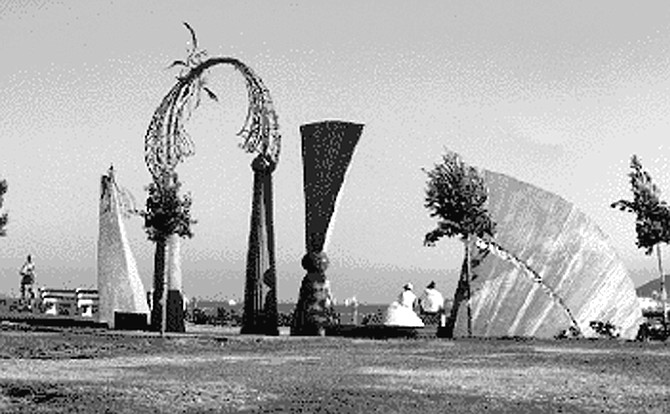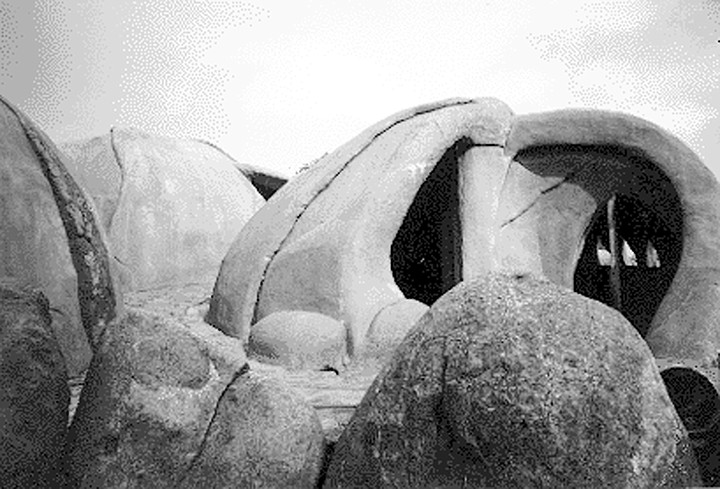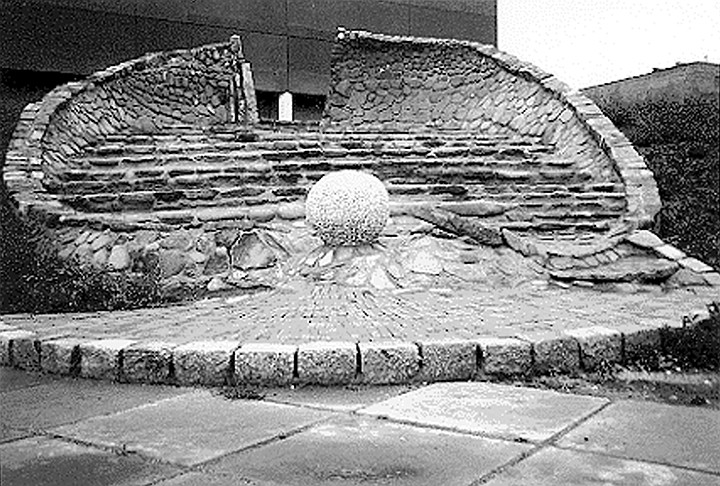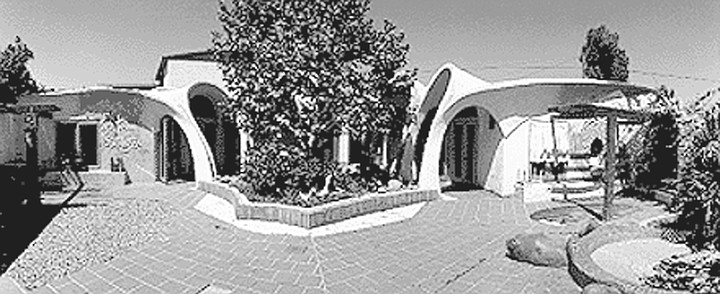 Facebook
Facebook
 X
X
 Instagram
Instagram
 TikTok
TikTok
 Youtube
Youtube

It’s surprising to learn that among lames Hubbell’s “idols” is Peter Paul Rubens. The 17th-century Flemish painter isn’t the first name that springs to mind when one first confronts Hubbcll’s artwork.

But then, if you look again at, say, Shelter Island’s Pacific Rim Park, it does seem a baroque confection. Designed and built by Hubbell in 1998 with the help of international architecture students, the park’s swirling fan-shaped sculptures are made of formed-and- poured concrete and topped by elaborate ironwork scribbles that from a distance appear to be tinsel.

It’s also true that classifying artists (himself included) into types according to style or period isn’t Hubbell’s way. “I think what’s just a little bit odd about how I think is that I’ve never been able to separate things,” he told a reporter last week. “I spent a lot of time with nature when I was young, and nature doesn’t separate things either. I think separating and trying to name things is peculiar only to the last 400 years of Western civilization.”

Besides, the main reason Hubbell “really respects” Rubens is because “he was an amazing artist and an amazing diplomat. He wasn’t somebody in a garret.”
Though Hubbell has lived and worked since 1958 in a cluster of buildings in Santa Ysabel that some people refer to as a “compound,” his way isn’t to be isolated or enclosed, either. That’s evident in the seven people he has working for him and in the locations of his other two Pacific Rim Park projects, in Vladivostok, Russia, completed in 1994, and Yantai, China, still being planned. Call it creative diplomacy. It equally applies to his projects in Mexico, among them a school in Tijuana and a chapel in Tecate.
In addition, he works on projects in partnership — with his son Drew — as Hubbell & Hubbell Art & Architecture.
While preparing his latest one- person show, Hubbell was asked to reflect on his older works, particularly those in San Diego — for example, the stained-glass windows of All Souls Episcopal Church on Catalina Boulevard and the facade of the courthouse in Vista. Did he ever visit them? How did he feel about what has happened to them or around them? “Well, some of them are gone,” he said, naming the lobby of the Alvarado Hospital. “That’s always hard. But, you know, when I was in the Army in Korea, I did a lot of work on the Non- Commissioned Officers’ Club, and a week after I was finished, it burned down. So I told myself, you can’t go back and worry about things like that. You have to do it because you want to do it. So I don’t really think about (the lost ones] that much.”
Despite his travels, the artist, who is in his late 60s, continues to find beauty and inspiration locally — at the missions, in the mountains, and at Torrey Pines, where he likes to walk and do watercolors. He calls the Pacific “a very friendly ocean, at least most of the time.”
Of Balboa Park he said, “I know from when I was working with environmental people down there that they always try to keep the city from encroaching on it. Well, I think what we should do is let Balboa Park encroach on the city — use that as an example of how the city should be.” But, he says, “I’m doing a talk in a couple of weeks, called ‘Mashed Potatoes, Jazz, and Architecture.’ I’m trying to tell the kids that inspiration can come from anything and anywhere.”
His new show, featuring drawings, watercolors, sculpture, stained glass, and jewelry, is called “Leaning West.” His readings and other preparations for the Chinese park project have been among its greatest influences. “I also have this idea that San Diego is really a Pacific Rim city, as Tijuana is. They really should be the host cities to the Pacific," he said. “Both of our futures are in the Pacific, not in Washington, D.C., or Mexico City. That’s partly what these parks are about. As it is now, they’re both these forgotten cities at the corner of a big, big nation.”
Why “forgotten”?
“San Diego doesn’t have the faith in itself that a place like New York or San Francisco has,” he said. “It’s partly the result of history. San Diego turned in on itself when the railroad went to Los Angeles instead of here and we became a cul-de-sac. The attitude makes doing good things here very difficult, because nobody thinks those things are all that important.”
But, he said, speaking metaphorically, “the railroad might come back. The developers used to have the most say as to what happened here. But now you have all the biotech and places like Qualcomm — international companies that look at the world as their world. That makes a huge difference.”
It sounded so optimistic. The artist himself never loses faith, it is proposed.
“I have a bad memory," he replied.
— Jeanne Schinto
“Leaning West”
New work by James Hubbell
Santa Ysabel Art Gallery
30352 Highway 78
(Intersection of Highway 79, seven miles below Julian)
Santa Ysabel Wednesday through Sunday through June 17
10:00 a.m. to 5:00 p.m.
Free Info: 760-765-1676


It’s surprising to learn that among lames Hubbell’s “idols” is Peter Paul Rubens. The 17th-century Flemish painter isn’t the first name that springs to mind when one first confronts Hubbcll’s artwork.

But then, if you look again at, say, Shelter Island’s Pacific Rim Park, it does seem a baroque confection. Designed and built by Hubbell in 1998 with the help of international architecture students, the park’s swirling fan-shaped sculptures are made of formed-and- poured concrete and topped by elaborate ironwork scribbles that from a distance appear to be tinsel.

It’s also true that classifying artists (himself included) into types according to style or period isn’t Hubbell’s way. “I think what’s just a little bit odd about how I think is that I’ve never been able to separate things,” he told a reporter last week. “I spent a lot of time with nature when I was young, and nature doesn’t separate things either. I think separating and trying to name things is peculiar only to the last 400 years of Western civilization.”

Besides, the main reason Hubbell “really respects” Rubens is because “he was an amazing artist and an amazing diplomat. He wasn’t somebody in a garret.”
Though Hubbell has lived and worked since 1958 in a cluster of buildings in Santa Ysabel that some people refer to as a “compound,” his way isn’t to be isolated or enclosed, either. That’s evident in the seven people he has working for him and in the locations of his other two Pacific Rim Park projects, in Vladivostok, Russia, completed in 1994, and Yantai, China, still being planned. Call it creative diplomacy. It equally applies to his projects in Mexico, among them a school in Tijuana and a chapel in Tecate.
In addition, he works on projects in partnership — with his son Drew — as Hubbell & Hubbell Art & Architecture.
While preparing his latest one- person show, Hubbell was asked to reflect on his older works, particularly those in San Diego — for example, the stained-glass windows of All Souls Episcopal Church on Catalina Boulevard and the facade of the courthouse in Vista. Did he ever visit them? How did he feel about what has happened to them or around them? “Well, some of them are gone,” he said, naming the lobby of the Alvarado Hospital. “That’s always hard. But, you know, when I was in the Army in Korea, I did a lot of work on the Non- Commissioned Officers’ Club, and a week after I was finished, it burned down. So I told myself, you can’t go back and worry about things like that. You have to do it because you want to do it. So I don’t really think about (the lost ones] that much.”
Despite his travels, the artist, who is in his late 60s, continues to find beauty and inspiration locally — at the missions, in the mountains, and at Torrey Pines, where he likes to walk and do watercolors. He calls the Pacific “a very friendly ocean, at least most of the time.”
Of Balboa Park he said, “I know from when I was working with environmental people down there that they always try to keep the city from encroaching on it. Well, I think what we should do is let Balboa Park encroach on the city — use that as an example of how the city should be.” But, he says, “I’m doing a talk in a couple of weeks, called ‘Mashed Potatoes, Jazz, and Architecture.’ I’m trying to tell the kids that inspiration can come from anything and anywhere.”
His new show, featuring drawings, watercolors, sculpture, stained glass, and jewelry, is called “Leaning West.” His readings and other preparations for the Chinese park project have been among its greatest influences. “I also have this idea that San Diego is really a Pacific Rim city, as Tijuana is. They really should be the host cities to the Pacific," he said. “Both of our futures are in the Pacific, not in Washington, D.C., or Mexico City. That’s partly what these parks are about. As it is now, they’re both these forgotten cities at the corner of a big, big nation.”
Why “forgotten”?
“San Diego doesn’t have the faith in itself that a place like New York or San Francisco has,” he said. “It’s partly the result of history. San Diego turned in on itself when the railroad went to Los Angeles instead of here and we became a cul-de-sac. The attitude makes doing good things here very difficult, because nobody thinks those things are all that important.”
But, he said, speaking metaphorically, “the railroad might come back. The developers used to have the most say as to what happened here. But now you have all the biotech and places like Qualcomm — international companies that look at the world as their world. That makes a huge difference.”
It sounded so optimistic. The artist himself never loses faith, it is proposed.
“I have a bad memory," he replied.
— Jeanne Schinto
“Leaning West”
New work by James Hubbell
Santa Ysabel Art Gallery
30352 Highway 78
(Intersection of Highway 79, seven miles below Julian)
Santa Ysabel Wednesday through Sunday through June 17
10:00 a.m. to 5:00 p.m.
Free Info: 760-765-1676
Comments